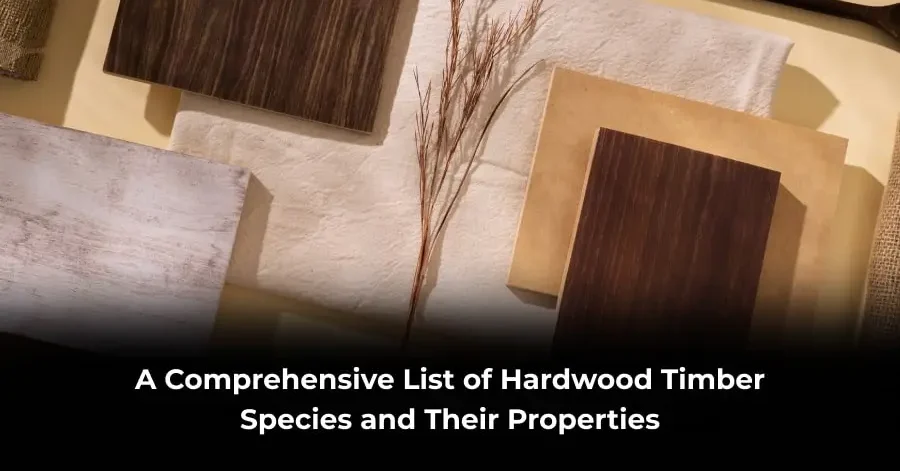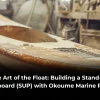Welcome, woodworkers, architects, and design enthusiasts! There’s a unique magic in working with wood. It’s a living, breathing material with a story etched into its grain. Whether you’re a seasoned professional searching for the perfect hardwood timber for sale or a hobbyist browsing a woodworking supplies store, the first and most crucial step is understanding the material itself. The world of hardwood is vast and varied, and choosing the right species can elevate your project from good to extraordinary.
This guide is your deep dive into the remarkable universe of hardwood timber species. We’ll explore their unique properties, aesthetics, and ideal uses, empowering you to make an informed choice for your next masterpiece.
The Foundation: What Exactly is Hardwood?
Before we jump into specific species, let’s clear up a common misconception. Hardwoods come from deciduous trees (trees that lose their leaves annually), not necessarily because they are all “hard.” While many are incredibly dense, like Hickory, others, like Balsa, are surprisingly soft and lightweight. The key identifier is the botanical structure of the tree.
Hardwoods are prized for their:
- Durability and Strength: They generally withstand wear and tear better than softwoods.
- Beautiful Grain Patterns: From the straight grain of Maple to the wild swirls of Elm, the variety is endless.
- Rich Color Palette: They offer a spectrum from the palest creams to the deepest ebony.
Now, let’s meet the stars of the show.
A Guide to Popular Hardwood Timber Species
- Oak (Red & White)
A classic choice that has dominated furniture and flooring for centuries.
- Properties: Strong, hard, and heavy with excellent resistance to moisture and wear. White Oak is more water-resistant than Red Oak.
- Appearance: Red Oak has a warm, light brown hue with a prominent grain. White Oak is darker, with a greyish-brown tone and a more subtle grain.
- Common Uses: Furniture, flooring, cabinetry, architectural trim, and wine barrels (White Oak).
- Workability: Machines well but can be challenging to hand-tool due to its density.
- Maple (Hard & Soft)
Known for its durability and clean, bright look.
- Properties: Extremely hard, strong, and resistant to abrasion. Hard Maple is one of the most durable domestic species.
- Appearance: A fine, uniform texture with a light, creamy color. It can feature fascinating patterns like “birdseye” or “curly” grain.
- Common Uses: Butcher blocks, bowling alleys, basketball courts, fine furniture, and kitchen cabinets.
- Workability: Can be difficult to work with due to its density and has a tendency to burn during machining.
- Walnut (American Black Walnut)
The epitome of elegance and a favorite for high-end woodworking.
- Properties: Strong and hard, but surprisingly easy to work with. It’s stable and durable.
- Appearance: A rich, dark brown chocolate color, often with lighter sapwood and striking purple or grey undertones. The grain is typically straight but can be wavy.
- Common Uses: Gunstocks, luxury furniture, veneer, carving, and decorative accents.
- Workability: A joy for woodworkers; it planes, sands, and turns beautifully.
- Mahogany (Genuine & African)
A name synonymous with quality and a rich, reddish-brown hue.
- Properties: Medium density, excellent stability, and good workability. It is resistant to rot and decay.
- Appearance: A straight, fine grain with a distinctive reddish-brown color that deepens with age.
- Common Uses: Boat building, high-end furniture, musical instruments, and paneling.
- Workability: Very easy to work with both hand and machine tools.
- Cherry (American Black Cherry)
A wood that matures beautifully, developing a deep patina over time.
- Properties: Moderately hard and strong with excellent stability. It is easy to machine and carve.
- Appearance: Starts as a light pinkish-brown and darkens to a rich, reddish amber when exposed to light. The grain is straight and fine.
- Common Uses: Fine furniture, cabinetry, flooring, and carving.
- Workability: Highly prized for its workability; it sands to a smooth, glass-like finish.
- Ash (White Ash)
Known for its exceptional strength and shock resistance.
- Properties: Very hard, heavy, and stiff with high shock resistance. It’s also remarkably flexible.
- Appearance: A pronounced, open grain with a light beige to light brown color.
- Common Uses: Tool handles, baseball bats, furniture, and flooring.
- Workability: Machines well and bends easily with steam.
- Teak
The king of outdoor and marine lumber, renowned for its natural oils.
- Properties: Extremely durable and naturally resistant to water, rot, decay, and insects due to its high oil content.
- Appearance: A golden-brown color when fresh, weathering to a silvery-grey. The grain is straight but can be interlocked.
- Common Uses: Boat decks, outdoor furniture, cutting boards, and exterior construction.
- Workability: Can be tough on tools due to its silica content, but finishes superbly.
Beyond the Classics: Introducing Okoume Wood
While the species above are well-known in North America and Europe, the global market offers incredible options. This is where reliable hardwood timber suppliers become essential, as they provide access to international species. One such remarkable wood is Okoume wood.
Often referred to as “Gaboon,” Okoume wood is a African species that has become a staple in certain industries. Don’t let its classification as a “hardwood” fool you; it’s relatively lightweight.
- Properties: Okoume wood is not durable in terms of rot resistance, but it is exceptionally stable, with minimal warping or shrinking. Its light weight and large panel sizes make it unique.
- Appearance: It has a uniform, fine texture with a straight grain. The color is a pale pink to salmon-brown, resembling Mahogany.
- Common Uses: Its primary use is in marine plywood for boat building. It’s also used for veneers, interior paneling, and light furniture.
- Workability: Okoume wood is a dream to work with. It cuts, sands, and glues effortlessly, making it a favorite for many applications where weight is a factor. When you’re looking for hardwood timber for sale for a marine project, Okoume wood plywood is often the top recommendation from knowledgeable hardwood timber suppliers.
Sourcing Your Materials: From Suppliers to Your Workshop
Finding the right wood is half the battle. You need trusted partners in the process. Whether you’re dealing with large-scale hardwood timber suppliers for a commercial project or your local woodworking supplies store for a weekend build, consider these factors:
- Quality and Grading: Reputable hardwood timber suppliers will clearly grade their lumber (FAS, Select, #1 Common, etc.), indicating the size and clearness of the boards.
- Sustainability: Look for suppliers who practice responsible forestry and offer FSC® or PEFC-certified woods.
- Knowledge: A good woodworking supplies store or supplier will have staff who can advise you on the best species for your project and its workability.
- Variety: The best hardwood timber suppliers will carry everything from domestic staples like Oak and Maple to exotic finds like Okoume wood and Ipe.
Before you make a purchase, it’s always wise to visit the woodworking supplies store or the yard of your hardwood timber suppliers to hand-pick your boards, checking for grain pattern, color, and any defects.
AEW Woods: Your Partner in Quality Timber
In the world of timber, finding a supplier that combines quality, variety, and reliability is key. This is where companies like AEW Woods have carved out a stellar reputation. AEW Woods is known as a premier source for a wide range of timber products, serving both trade and individual clients.
They understand that every project has unique demands. Whether you are a boatbuilder in need of premium Okoume wood marine plywood, a furniture maker seeking the finest hardwood timber for sale, or a contractor requiring consistent and reliable material, AEW Woods positions itself as one of the go-to hardwood timber suppliers. Their commitment to sourcing sustainable and high-quality products makes them a trusted name. By stocking everything from standard lumber to specialized sheet materials, they essentially function as a comprehensive woodworking supplies store on a larger scale, ensuring that professionals and enthusiasts alike have access to the materials they need to succeed.
Also Read – 5 Mistakes to Avoid When Buying Timber for High-End Projects
Conclusion
The journey through the forest of hardwood species is a rewarding one. From the timeless strength of Oak to the nautical prowess of Okoume wood, each timber has a unique personality and purpose. Understanding their properties is the first step in a successful project. Remember, the wood you choose is the soul of your creation.
Whether you’re sourcing from large-scale hardwood timber suppliers for a big build or picking up a board from your local woodworking supplies store, let this guide be your compass. And for those seeking a reliable partner in quality, companies like AEW Woods demonstrate the importance of trusted hardwood timber suppliers in bringing these beautiful natural resources from the forest to your workshop. So go ahead, find the perfect hardwood timber for sale, and create something that will last for generations.
Frequently Asked Questions (FAQs)
- What is the most durable hardwood for outdoor furniture?
Teak is the gold standard due to its natural oil content that repels water and insects. Ipe and Cumaru are also excellent, extremely dense choices for outdoor use, often referred to as “ironwoods.” - Where can I find exotic hardwood timber for sale?
Specialist hardwood timber suppliers and larger lumberyards typically stock exotic species. Online hardwood timber suppliers also offer a vast selection, though seeing the wood in person is often preferable. A well-stocked woodworking supplies store may carry smaller pieces of exotic woods. - Is Okoume wood suitable for outdoor projects?
While Okoume wood itself has poor natural durability, when used as a core for marine-grade plywood and properly sealed with epoxy and fiberglass, it becomes an excellent and lightweight material for boat hulls and other marine applications. Untreated, it is not suitable for prolonged outdoor exposure. - What’s the best hardwood for a beginner woodworker?
Poplar and Soft Maple are fantastic starting points. They are relatively inexpensive, readily available at any woodworking supplies store, and much easier to machine and hand-tool than denser species like Oak or Hickory. - How do I choose between so many hardwood timber suppliers?
Look for suppliers with positive reviews, transparent pricing, and clear grading rules. A supplier’s willingness to answer questions and offer advice is a great indicator of their customer service. For small projects, your local woodworking supplies store is often the most convenient and helpful option.






